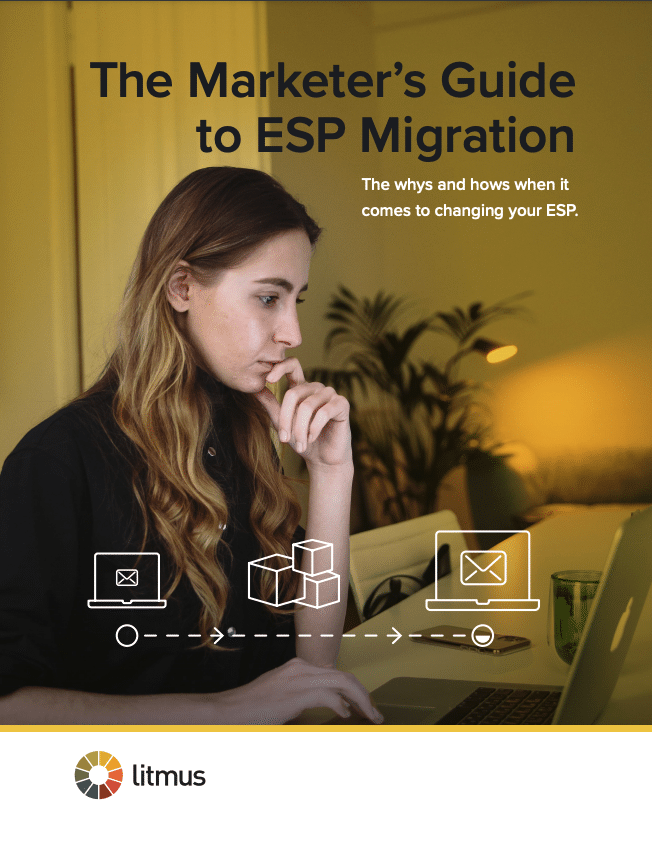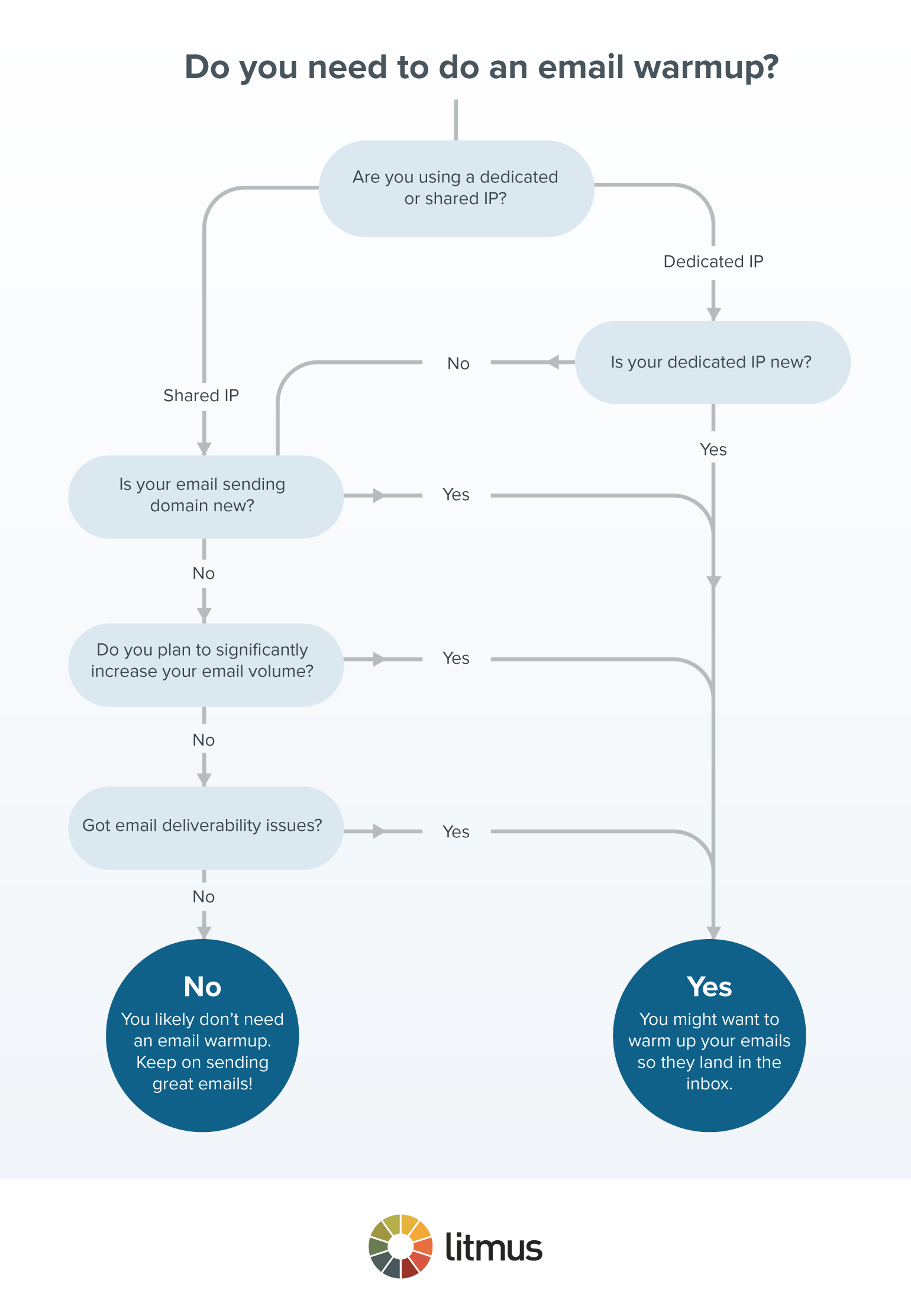Planning a New IP or Domain? Here’s How To Do an Email Warm-Up
Yay! You’ve got (or are getting) a new email domain or IP address to send emails from—but wait. Is it warm?
Before you go full throttle, you have to make sure you do a proper email warm-up or else risk being seen as a spammer and ending up in people’s junk folders instead. Yikes. Not the fresh start you want for your email marketing program.
And there are many reasons why you might want or need to start anew. Maybe you’re switching to another email service provider (ESP) or getting started with one for the first time. Or perhaps you’re rebranding or going through an acquisition or merger. Maybe you’ve decided to go from a shared IP to a dedicated IP or from your parent domain to a subdomain just for emails.
Even large spikes in email volume that deviate from your norm—like Black Friday and Cyber Monday—should be approached with a warm-up. Or worst-case scenario? You’re seeing massive deliverability issues and need to start over.

| Migrating ESPs? From researching vendors to moving everything over, switching to a new ESP is no small task. Make it as easy as possible with our step-by-step guide and templates for quick, fill-in-the-blanks documentation. |
Whatever the case, you need to warm up your new IP, domain, or subdomain. And you need to do it right.
We’ve got you covered. In this blog post, you’ll learn:
- What an IP and domain warm-up is
- When you do (and don’t) need to warm up
- How to do email warming right
- How long it takes (+ sample schedule)
What’s an IP or domain warm-up?
Email IP or domain warming is slowly sending emails from a new IP address or domain name and gradually increasing send volume over time.
As you do this, internet service providers (ISPs) like Hotmail and Gmail determine whether or not they should deliver your emails to the inbox or the spam folder. This is based on many factors, one of which is positive email engagement as a signal that you’re not a spammer.
The more trust you build with them and your recipients, the more likely ISPs will place your emails in the inbox. You start an IP or domain warm-up by sending a limited number of emails to establish the reputation.
As you build trust, you can ramp up your normal send volume. Then your deliverability has a solid foundation moving forward, as long as you maintain positive sending standards.
Do you need to warm up if…
Since email warming takes time and coordination, it’s not something most people want to do just for fun. Here’s how to assess whether or not you need to do an IP or domain warm-up.
You’re on a new shared IP address? Probably not. If it’s completely new, then yes, it’ll need to be warmed up. But chances are, your shared IP is already warm, thanks to the other brands using it previously.
You have a new dedicated IP with a new domain? Absolutely! With both your IP and domain being new, you don’t want to take any chances of damaging either reputation.
You have a new dedicated IP address with the same domain? Yes. Many ISPs primarily look at your IP, so you’ll be seen as an unknown sender even if you’re using a trusted domain.
You have a new domain with the same IP? Yep—especially if you have a large Gmail audience (including Google Suite).
You have a new subdomain from a warm domain? Yes. ISPs view new subdomains as unknown senders.
You have the same IP and the same domain? Only if your reputation and deliverability are completely trashed.

The dos and don’ts of IP/domain warming for email
The best IP and domain warming strategies make their list and check it twice. It doesn’t hurt to get expert advice, either. That’s why we asked our very own Senior Manager of Email Marketing, Jaina Mistry for insights. She’s gone through quite a few warm-ups and shared tips for implementing a seamless domain or IP transition.
Do identify your best-performing emails
IP and domain warm-ups are your chance to make a good first impression with ISPs, so put your best foot forward. Jaina suggests:
“The first emails you’ll send from your new space should be messages with the highest open rates and click-to-open rate (CTOR). Pick message types from the last 6-9 months that perform best, whether they’re one-off marketing sends or triggered emails.”
When we at Litmus set about warming up a new IP, we led with a mix of top-performing emails:
- The Litmus Weekly newsletter
- Triggered follow-ups after content downloads
- Premium content announcements, like reports and ebooks
Do identify your most engaged audience
Send your best emails to your most engaged subscribers to stack the odds even more in your favor. Picking the people and segments who regularly open and click through signals ISPs that you have an active audience.
For Litmus, Jaina found the best subscribers for IP or domain warming by looking at the previous three months of data. How far back you look will depend on your sending cadence, though. For example:
- If you’re only sending one email per month, you’ll want to look at subscribers who’ve opened and clicked on your last three emails.
- If you’re sending one email per week, it could be a good idea to look at subscribers who’ve opened and clicked on at least three emails per month for the last three months.
Do plan a timeline for your IP/domain warming
Setting a timeline for how long you have to warm up an IP lets you work backward to determine your sending plan. 4-8 weeks is a standard migration timeframe, and more time lets you send more slowly and pay close attention to performance before moving on. We have a warm-up plan below to help you decide exactly how to spend those 4-8 warm-up weeks.
Don’t rush it
Slow and steady wins the domain and IP warming race. You’ll probably have a date when you need to leave your previous ESP, domain, or IP, but you’ll want to allow some time for any hiccups that may arise.
If possible, continue to send the rest of your scheduled messages from your old IP or domain. Having an already warm place to send emails is a convenient fallback while you’re building up your new IP or domain. You will have to leap from the old to the new eventually, however.

“When warming up, we kept sending email from our old IP address, too, and didn’t see any impact—gotta keep that plane flying! But do have a cut-off date when you’ll stop sending email from your old IP or sending domain.”
– Jaina Mistry, Senior Manager of Email Marketing at Litmus
If you’re warming up a new subdomain on the same IP and domain, you might not have a cut-off date like you would if you were changing ESPs.
Do monitor email performance like a hawk
After each send on your new IP or domain, check email performance. Keeping a close eye on opens and click-through rates to ensure they’re in line with what you expect lets you catch any deliverability issues early.
If you notice a dip in engagement, use your next send to hone in on an even smaller, highest-engaged audience. If you’re switching ESPs, your new service may have a deliverability partner to help you monitor your warm-up.
Don’t just look at overall performance
Beyond looking at open and click rates for warm-up sends, investigate performance on a per-ISP basis. Check performance between ISPs to make sure one client isn’t showing deliverability concerns.
If you spy something fishy with a particular ISP, isolate email addresses for that ISP for the subsequent sends. For example, if you notice an issue with Gmail, remove all Gmail users from the next batch of warm-up emails you plan to send.
Then, analyze your list of Gmail subscribers to find the most active of the bunch, and try again with those subscribers. Start with small volumes and work your way up until engagement is as expected.
 | Get insights into your audience Measure deeper email insights such as read rates and email client usage. So you can identify your most engaged subscribers for a successful email warm-up. |
Don’t sweat the opt-outs
Notice a few unsubscribes from emails you sent with your new IP or domain? No worries. Some unsubscribes won’t impact your deliverability during an IP warm-up, especially if positive engagement signals are higher.
Do keep monitoring email engagement afterward
While the first year on a new domain or IP is especially important for establishing deliverability, your reputation is ongoing. You should always monitor email engagement and your sender reputation, since it may only take one slip up to ruin your inbox placement. Even the best of warm-up strategies can’t make your deliverability error-proof.
Do be prepared to stop sending if engagement drops
It’s helpful to keep your old domain or IP while warming up another if something goes awry. Plan to keep your previous one for at least a month, but up to three months if possible. That way, you can pause sending from the new IP or domain to investigate dips in engagement without halting your email program entirely.
If you don’t have your old IP or domain for backup, you may need to halt at least some of your messages if you notice a problem during warm up.
Don’t send large spikes in email volume
As you progress on your email warming plan, you’ll gradually send more emails from the new domain or IP. We have advice on what percent of emails to send during warm up, but the most important thing is to avoid spikes in send volume. You can even split up your usual large batches of emails into sublists to use a consistent, smaller daily send volume.
Do continually test for spam filters
In addition to monitoring email performance on your new domain or IP, check for spam filters. Using a tool like Litmus Spam Testing lets you find any blocklists or spam filters that might be getting in the way of your new sending.
 | Make it to the inbox—not the junk folder Identify issues that may land your emails in the spam folder—with contextual advice to fix deliverability problems before you send. |
How long does it take to warm up emails?
You should plan to spend 4-8 weeks (or more) warming up a new IP or domain before completely cutting off the old one. When Jaina recently changed ESPs for Litmus, she worked in a tighter 4-week timeframe. But, she shared that eight weeks is more standard for an IP or domain warm-up.
You’ll send your most popular content to an increasingly larger portion of your most engaged subscribers during email warm-up. During the first week, only use your new domain or IP to email 1% of your best subscribers. Then, you can double recipients each week (to 2% of subscribers, then 4%, and so on). At week eight, you’ll send your most popular content to all of your top subscribers. Assuming all is going well, you can ease into sending messages to the rest of your subscribers after that.
Here’s a sample 8-week warm-up plan of which emails to send on your new domain or IP:
| Who should I send my popular content to during a domain or IP warm-up? | |
|---|---|
| During this week… | Send to this percent of most engaged subscribers |
| 1 | 1% |
| 2 | 2% |
| 3 | 4% |
| 4 | 8% |
| 5 | 16% |
| 6 | 32% |
| 7 | 64% |
| 8 | 100% |
Of course, your ideal email warming plan could deviate from this.
You may choose to ease into the new domain or IP more slowly if you have a longer runway with your old one, are working up to a high send volume, only send emails a few times a month, or have low engagement. You could also ramp up more quickly if you have a low send volume or highly engaging email marketing program.
We wouldn’t recommend granting less than four weeks to email warming.
Warming up IPs and domains is critical for email deliverability
Email warming is not something you should skip or take lightly. ISPs use complex algorithms that include looking at your IP, domain, and email engagement. When you have a new IP, domain, or subdomain—even if you’re an established brand—they see you as a new sender. And you know who changes IPs often? Spammers.
That means ISPs are (rightfully) skeptical. If you gradually send more emails from your new IP or domain and keep a close eye on engagement, deliverability, and spam filters, you’ll be on your way to high deliverability.
 | Identify deliverability issues with Litmus Spam Testing 70% of emails show at least one spam-related issue that could keep them from reaching the inbox. Don’t let your email be one of them. Litmus scans your emails against 25+ different tests, identifies any issues, and provides actionable advice for how to fix them. |

Steph Knapp
Steph Knapp is a Freelance Content Writer for SaaS and B2B companies
